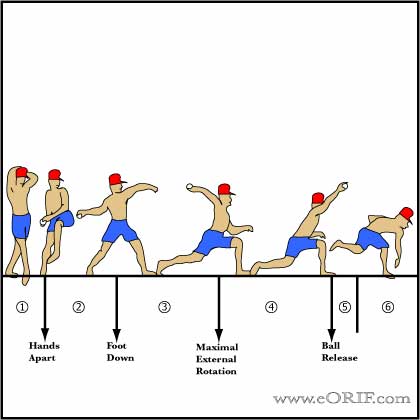|
 
|
synonyms: valgus extension overload syndrome, posterior elbow impingement, posteromedial elbow impingement
Posteromedial Elbow Impingement ICD-10
Posteromedial Elbow Impingement ICD-9
- 715.12 (osteoarthritis, localized primary, forearm)
Posteromedial Elbow Impingement Etiology / Epidemiology / Natural History
- Posterior elbow pain caused by mechanical abutment of bone and soft tissues in the olecranon fossa which leads to osteophyte formation inthe medial aspect of the olecranon fossa. Often associated with UCL instability.
- May be caused by Valgus extension overload syndrome in throwing athletes / pitchers. Valgus extension overload is characterized by posteromedial olecranon osteophytes, chondromalacia of the medial wall fo the olecranon fossa, tension on the medial ulnar collateral ligament and compression of the radiocapitellar joint.
- May be caused by repetitive hyperextension injury such as in gymnastic, football lineman, boxers (Valkering KP, AJSM 2008:36:328) and weightlifters.
- Most common diagnosis requiring surgery in baseball players. (Andrews JR,AJSM 1995;23: 407).
Posteromedial Elbow Impingement Anatomy
- Resection of >3mm of the posteromedial olecranon increases strain in the UCL; (mm resection produces marked valgus angulation. (Kamineni S, JBJS 2003;85A:1005).
- See also Elbow Anatomy.
Posteromedial Elbow Impingement Clinical Evaluation
- Posterior elbow pain reproduced with forced elbow hyperextension. Generally occurs in the deceleration phase of throwing.
- Loss of full extension (flexion contracture) often noted.
- May have posteromedial tenderness, evalate for MCL tenderness which may indicate associated MCL injury.
- Valgus stress test: may reveal valgus instability or medial and posteromedial pain indicating posteromedial elbow impingement.
- Moving valgus stress test: may indicate associated MCL injury.
- Locking or catching may indicate a loose body.
Posteromedial Elbow Impingement Xray / Diagnositc Tests
- A/P, lateral and oblique elbow xrays indicated. Evaluate for olecranon fossa and olecranon tip osteophytes. Evaluate for loose bodies.
- MRI: eval for loose bodies, integrity of UCL.
- CT: eval for loose bodies
Posteromedial Elbow Impingement Classification / Treatment
- Initial treatment: activity modifications (refrain from painful activites, no pitching etc), active rest, shoulder and elbow rehab exercises, NSAIDs, until patient is pain free and non-tender. Progress with throwing program once symptoms have resolved. Consider steroid injection.
- Surgical treatment: diagnostic Elbow Arthroscopy with olcranon osteophyte debridement. Indicated after failure of non-operative treatment. Olecranon resection should be limited to the osteophytes only. Resection of >3mm of the olecranon leads to overload of the anterior bundle of the MCL (Kamineni S, JBJS 2003;85A:1005). Ensure there is not an associated Medial Elbow Instability . Concommittant MCL injury is common in throwing athletes but not boxers/gymnast/football lineman.
Posteromedial Elbow Impingement Associated Injuries / Differential Diagnosis
Posteromedial Elbow Impingement Complications
Posteromedial Elbow Impingement Follow-up Care
- Post-op: compressive dressing, elevation
- 1 week: Start PT focused on ROM and strengthening. AAROM, PROM. AROM, free weights start at 3 weeks.
- 6 weeks: progressive sport specific activity.
- 3 months: Return to sport / full activities.
- Elbow Arthroscopy Rehab Protocol
- Elbow Outcome Measures
Posteromedial Elbow Impingement Review References
|


